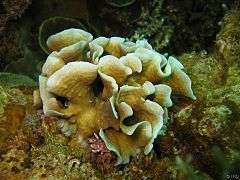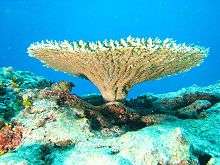Pavona (coral)
Pavona is a genus of colonial stony corals in the family Agariciidae. These corals are found in shallow waters in the Indo-Pacific region.
| Pavona | |
|---|---|
_-_GRB.jpg) | |
| Potato chip coral (Pavona cactus) | |
| Scientific classification | |
| Kingdom: | Animalia |
| Phylum: | Cnidaria |
| Class: | Anthozoa |
| Order: | Scleractinia |
| Family: | Agariciidae |
| Genus: | Pavona Lamarck, 1801[1] |
| Species | |
|
| |
| Synonyms | |
|
List
| |
Characteristics
Corals in this genus have a range of different forms including those that are massive, meandering, columnar, leaf-like, and plate-like. A single species may vary in form according to the current, wave action, lighting conditions, and depth of its location. Members of the genus are distinguished from other corals by having no walls to the corallites, but having clearly delineated septocostae that connect each corallite to its neighbours, giving a flower-like pattern on the surface of the coral. The corallites themselves are shallow depressions with central columella and may be separated by ridges. The polyps, with the exception of Pavona explanulata, are only extended at night. The foliose and plate-like forms tend to be two-sided.[1][2] If they do not get enough nutrients or “food” from photosynthesis they switch to the autotrophic mode, and obtain some of their nutrition from their symbiotic algae. They can also absorb nutrients from uptaking dissolved organics from the water and even using carbon dioxide to turn it in organic carbon sources they can feed on.[3]
Species
The World Register of Marine Species recognises these species:[1]
|
|


 Pavona clavus
Pavona clavus

 Pavona explanulata
Pavona explanulata Pavona frondifera
Pavona frondifera
 Pavona minuta
Pavona minuta Pavona varians
Pavona varians Pavona venosa
Pavona venosa
References
- Martinez, Olga (2012). "Pavona Lamarck, 1801". WoRMS. World Register of Marine Species. Retrieved 2013-01-23.
- "Pavona". Coral Hub. CICBP. Archived from the original on 2013-04-16. Retrieved 2013-01-23.
- "Pavona Coral - Cactus Coral - Many Images". REEF2REEF Saltwater and Reef Aquarium Forum. Retrieved 2018-11-08.
